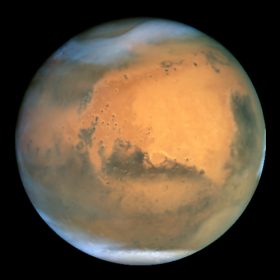Mars is named for the ancient Roman god of war. The Greeks called the planet Ares. The Romans and Greeks associated the planet with war because its color resembles the color of blood.
Mars has two small moons. Their names are Phobos and Deimos. They are named for the sons of Ares, the Greek god of war. Phobos means "fear," and Deimos means "flight."
WHAT IS MARS LIKE?
Mars is very cold. The average temperature on Mars is minus 80 degrees Fahrenheit - way below freezing!Its surface is rocky, with canyons, volcanoes, dry lake beds and craters all over it. Red dust covers most of its surface. Mars has clouds and wind just like Earth. Sometimes the wind blows the red dust into a dust storm. Tiny dust storms can look like tornados and large ones can be seen from Earth. Mars' large storms sometimes cover the whole planet.
Mars has about one-third the gravity of Earth. A rock dropped on Mars would fall more slowly than a rock falls on Earth. A person who weighs 100 pounds on Earth would only weigh about 37 pounds on Mars because of the reduced gravity.
Mars' atmosphere is much thinner than Earth's. The atmosphere of Mars contains more than 95 percent carbon dioxide and much less than 1 percent oxygen.
WHAT HAS NASA LEARNED ABOUT MARS?
NASA has used both spacecraft and robots to learn more about Mars. In 1965, Mariner 4 flew past Mars and became the first NASA spacecraft to take close-up images of another planet. In 1976, Viking 1 and Viking 2 were the first NASA spacecraft to land on Mars. Both spacecraft took images and collected science data on the Martian surface.Since then, several spacecraft have orbited or landed on Mars. Scientists are particularly interested in searching for clues of water on Mars. Living things need water to survive. So, finding evidence that water exists or used to exist on Mars would mean that there could be or could have been life on the planet.
NASA's Spirit and Opportunity rovers found evidence that water once flowed on Mars when they found minerals that only form in water. NASA's Mars Global Surveyor orbited the Red Planet for nine years. The orbiter found that Mars once had a magnetic field like Earth's that shielded it from deadly cosmic rays.
HOW IS NASA EXPLORING MARS TODAY?
Today, three NASA spacecraft are orbiting Mars. The spacecraft are using scientific tools to collect information about things like climate, topography and the kinds of minerals on Mars. They are taking pictures and continuing to search for water.Two rovers, Opportunity and Curiosity, are working on the surface of Mars. They are taking pictures and studying the planet's soil and rocks. Rovers are robots that drive around. They send the pictures and data back to Earth. NASA uses the images and information gathered by the spacecraft and rovers to learn more about Mars.
HOW WILL NASA EXPLORE MARS IN THE FUTURE?
NASA plans to send more robots to Mars. An orbiter named MAVEN started its orbit of Mars in September 2014. MAVEN studies Mars' atmosphere. NASA plans to send a lander to Mars in 2016. And a new Mars rover is planned for launch in 2020. NASA wants robots to, some day, collect Martian soil and rocks and bring them back to Earth to be studied.After robots have explored the Red Planet and brought back soil samples, NASA wants to send astronauts there. To prepare to send humans to Mars, NASA is researching new kinds of homes where astronauts can live. Scientists are studying how people living in space can grow plants for food. To find out how living in space affects humans, NASA studies what happens to astronauts on the International Space Station.





